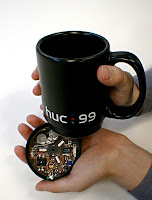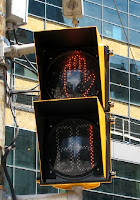Together with Thomas Kubitza I was teaching a class in the UBI summer school on Developing Ubiquitous Computing Devices. The summer school was held in Oulu and organized by Timo Ojala.
In total the summer school include the following 4 courses:
- EXPERIENCE-DRIVEN DESIGN OF UBIQUITOUS INTERACTIONS IN URBAN SPACES Prof. Kaisa Väänänen-Vainio-Mattila, Tampere University of Technology, Finland & Dr. Jonna Häkkilä, University of Oulu, Finland
- DESIGNING MOBILE AUGMENTED REALITY INTERFACES Prof. Mark Billinghurst, University of Canterbury, New Zealand
- DEVELOPING UBIQUITOUS COMPUTING DEVICES Prof. Albrecht Schmidt, University of Stuttgart, Germany
- URBAN RESOURCE NETWORKS Prof. Malcolm McCullough, University of Michigan, USA
 There was more than work… if you are curious have a look at flickr for photos and more photos.
There was more than work… if you are curious have a look at flickr for photos and more photos.
As some people asked for the reading list for our course on Developing Ubiquitous Computing Devices, I thought I post it here…. The reading list is also available as PDF for download.
The reading list comprises 4 areas that are relevant to our course. We expect that you have come across the original paper by Marc Weiser, introducing the concept of ubiquitous computing [1].
In the first part we have included papers that provide an overview of interaction concepts that are relevant in the context of ubiquitous computing. In particular this is tangible interaction [2a] [2b], reality based interaction [3], embedded interaction [4]. The concept of informative art [5] is introduced as well as the notion of persuasive technologies [16].This part is concluded with an overview of interaction with computers in the 21st century [6].
 In the second part we have included a paper on how to create smart devices [7], which gives an overview of sensors that may be useful for creating novel and reactive devices. In [8] sensing is extended to context and context-awareness. In the third part we introduce the .NET Gadgeteer platform [9] and show some trends in the development of ubiquitous computing devices: how can we create new products once we can fabricate things [10] and enclosures [10b] and how ubicomp technologies enable new devices and devices concepts [11].
In the second part we have included a paper on how to create smart devices [7], which gives an overview of sensors that may be useful for creating novel and reactive devices. In [8] sensing is extended to context and context-awareness. In the third part we introduce the .NET Gadgeteer platform [9] and show some trends in the development of ubiquitous computing devices: how can we create new products once we can fabricate things [10] and enclosures [10b] and how ubicomp technologies enable new devices and devices concepts [11].
The final part provides some ideas for application scenarios that we plan to assess during the course. In [12] a concept of how to change a bed into a communication media is presented and in [13] a social alarm clock is presented. A recent study [14] shows the impact of technology on communication and in [15] an overview of novel alarm clocks and sleep monitoring devices is given.
References
[1] Weiser, M. (1991). The computer for the 21st century. Scientific american,265(3), 94-104. http://wiki.daimi.au.dk/pca/_files/weiser-orig.pdf
[2a] Ishii, H., & Ullmer, B. (1997, March). Tangible bits: towards seamless interfaces between people, bits and atoms. In Proceedings of the ACM SIGCHI Conference on Human factors in computing systems (pp. 234-241). ACM. http://doi.acm.org/10.1145/258549.258715 http://labs.rightnow.com/colloquium/papers/tangiblebits.pdf
[2b] Ishii, H. (2008, February). Tangible bits: beyond pixels. In Proceedings of the 2nd international conference on Tangible and embedded interaction (pp. xv-xxv). ACM. http://doi.acm.org/10.1145/1347390.1347392
[3] Jacob, R. J., Girouard, A., Hirshfield, L. M., Horn, M. S., Shaer, O., Solovey, E. T., & Zigelbaum, J. (2008, April). Reality-based interaction: a framework for post-WIMP interfaces. In Proceedings of the SIGCHI conference on Human factors in computing systems (pp. 201-210). ACM. http://doi.acm.org/10.1145/1357054.1357089 http://research.cs.queensu.ca/~audrey/papers/chi08.pdf
[4] Kranz, M., Holleis, P., & Schmidt, A. (2010). Embedded interaction: Interacting with the internet of things. Internet Computing, IEEE, 14(2), 46-53. http://dx.doi.org/10.1109/MIC.2009.141 http://pure.ltu.se/portal/files/39756776/FINAL_PRINT_w2iot_preprint.pdf
[5] Ferscha, A. (2007). Informative art display metaphors. In Universal Access in Human-Computer Interaction. Ambient Interaction (pp. 82-92). Springer Berlin Heidelberg. http://www.pervasive.jku.at/Research/Publications/_Documents/InformativeArtDisplayMetaphors-ferscha2007.pdf
[6] Schmidt, A., Pfleging, B., Alt, F., Sahami, A., & Fitzpatrick, G. (2012). Interacting with 21st-Century Computers. Pervasive Computing, IEEE, 11(1), 22-31. http://www.hcilab.org/wp-content/uploads/schmidt-ieeepc-21century.pdf http://dx.doi.org/10.1109/MPRV.2011.81
[7] Schmidt, A., & Van Laerhoven, K. (2001). How to build smart appliances?.Personal Communications, IEEE, 8(4), 66-71. http://www.comp.lancs.ac.uk/~albrecht/pubs/pdf/schmidt_ieee_pc_08-2001.pdf
[8] Schmidt, A. (2013). Context-Aware Computing: Context-Awareness, Context-Aware User Interfaces, and Implicit Interaction. The Encyclopedia of Human-Computer Interaction, 2nd Ed. http://www.interaction-design.org/encyclopedia/context-aware_computing.html
[9] Villar, N., Scott, J., Hodges, S., Hammil, K., & Miller, C. (2012). . NET gadgeteer: a platform for custom devices. In Pervasive Computing (pp. 216-233). Springer Berlin Heidelberg. http://research.microsoft.com/pubs/163162/Gadgeteer%20Pervasive%202012%20Proof.pdf
[10] Schmidt, A., Doring, T., & Sylvester, A. (2011). Changing How We Make and Deliver Smart Devices: When Can I Print Out My New Phone?. Pervasive Computing, IEEE, 10(4), 6-9. http://www.hcilab.org/wp-content/uploads/2012/04/schmidt2011changing.pdf http://dx.doi.org/10.1109/MPRV.2011.68
[10b] Weichel C., Lau M., Gellersen,H. (2013). Enclosed: A Component-Centric Interface for Designing Prototype Enclosures. Tangible, embedded, and embodied interaction conference (TEI 2013) http://doi.acm.org/10.1145/2460625.2460659 http://www.csweichel.de/papers/2013-enclosed.pdf
[11] Hodges, S., Villar, N., Scott, J., & Schmidt, A. (2012). A New Era for Ubicomp Development. Pervasive Computing, IEEE, 11(1), 5-9. http://dx.doi.org/10.1109/MPRV.2012.1 http://research.microsoft.com/pubs/163175/ANewEraForUbiCompDevelopment-IEEEPervasiveComputing.pdf
[12] Dodge, C. (1997, March). The bed: a medium for intimate communication. InCHI’97 extended abstracts on Human factors in computing systems: looking to the future (pp. 371-372). ACM. http://doi.acm.org/10.1145/1120212.1120439
[13] Schmidt, A., Shirazi, A. S., & van Laerhoven, K. (2012). Are You in Bed with Technology?. Pervasive Computing, IEEE, 11(4), 4-7. http://dx.doi.org/10.1109/MPRV.2012.63
[14] Schmidt, A. (2006). Network alarm clock (The 3AD International Design Competition). Personal and Ubiquitous Computing, 10(2-3), 191-192. http://dx.doi.org/10.1007/s00779-005-0022-y http://old.hcilab.org/documents/Schmidt_NetworkAlarmClock.pdf
[15] Shirazi, A. S., Clawson, J., Hassanpour, Y., Tourian, M. J., Schmidt, A., Chi, E. H., Borazio, M., & Van Laerhoven, K. (2013). Already Up? Using Mobile Phones to Track & Share Sleep Behavior. International Journal of Human-Computer Studies. http://www.sciencedirect.com/science/article/pii/S1071581913000244
[16] Fogg, B. J. (2009, April). A behavior model for persuasive design. In Proceedings of the 4th international conference on persuasive technology (p. 40). ACM. http://bjfogg.com/fbm_files/page4_1.pdf
Appendix: .NET Gadgeteer Links (optional)
- Home website of the .NET Gadgeteer project http://www.netmf.com/gadgeteer/
- Starting point for the hardware we use in the workshop (FEZ Spider Kit), follow steps 1-3 (choose VS C# Express 2010) to setup your development environment for the workshop in advance (only for MS Windows) http://www.ghielectronics.com/support/.net-micro-framework
- MSDN Gadgeteer Blog – What is going on?! http://blogs.msdn.com/b/net_gadgeteer/
- Get an overview of available Hardware! Think about what you always wanted to build! http://gadgeteering.net/hardware
- Very useful Gadgeteer hints by Steven Johnston http://stevenjohnston.co.uk/category/net-gadgeteer/
- Various interesting Gadgeteer projects http://mikedodaro.net/
- First Gadgeteer Project Video by Nic Villar http://www.ghielectronics.com/docs/43/first-gadgeteer-project


































